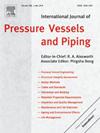Effect of weld oxides on hydrogen induced cracking of API X65 sour high frequency induction welded pipe
IF 3
2区 工程技术
Q2 ENGINEERING, MECHANICAL
International Journal of Pressure Vessels and Piping
Pub Date : 2025-03-21
DOI:10.1016/j.ijpvp.2025.105516
引用次数: 0
Abstract
High Frequency Induction Welded (HFIW) sour API pipes have become a popular choice for use in sour service. Failure to completely expel weld oxides during seam welding may lead to failures in Hydrogen Induced Cracking (HIC) tests. Weld failures in HIC tests of API X65 sour HFIW pipes made from two steel coils (A & B) was investigated. Electron microscopy studies showed that the presence of entrapped weld oxides of length < 10 μm and aspect ratio > 6 along the bondline. After taking into consideration the effect of microstructure and texture, weld oxides were found to be the reason for HIC failure. The sequential alignment and the thin, elongated morphology of the oxides caused the propagation of HIC cracks along the weld bondline. Weld with narrower bondline of 28.91 μm was found to perform better in HIC and impact toughness tests (91 J energy at - 30 °C compared to 67.33 J for the weld having wider bondline of 42.47 μm). In some cases, HIC cracks were also observed in the Heat Affected Zone (HAZ) caused by inclusions present in the base steel.
焊缝氧化物对API X65酸性高频感应焊管氢致开裂的影响
高频感应焊接(HFIW)酸性API管道已成为酸性应用的热门选择。在焊缝焊接过程中不能完全排出焊缝氧化物可能导致氢致开裂(HIC)试验失败。API X65含酸HFIW管的HIC试验焊缝失效(A &;B)被调查。电镜研究表明,焊缝中存在长度为<;10 μm,纵横比>;沿着边界。综合考虑组织和织构的影响,发现焊缝氧化物是HIC失效的原因。氧化物的顺序排列和薄而细长的形貌导致HIC裂纹沿焊缝结合线扩展。结合线较窄为28.91 μm的焊缝在HIC和冲击韧性测试中表现较好(- 30°C时能量为91 J,而结合线较宽为42.47 μm的焊缝能量为67.33 J)。在某些情况下,在基体钢中存在的夹杂物引起的热影响区(HAZ)也观察到HIC裂纹。
本文章由计算机程序翻译,如有差异,请以英文原文为准。
求助全文
约1分钟内获得全文
求助全文
来源期刊
CiteScore
5.30
自引率
13.30%
发文量
208
审稿时长
17 months
期刊介绍:
Pressure vessel engineering technology is of importance in many branches of industry. This journal publishes the latest research results and related information on all its associated aspects, with particular emphasis on the structural integrity assessment, maintenance and life extension of pressurised process engineering plants.
The anticipated coverage of the International Journal of Pressure Vessels and Piping ranges from simple mass-produced pressure vessels to large custom-built vessels and tanks. Pressure vessels technology is a developing field, and contributions on the following topics will therefore be welcome:
• Pressure vessel engineering
• Structural integrity assessment
• Design methods
• Codes and standards
• Fabrication and welding
• Materials properties requirements
• Inspection and quality management
• Maintenance and life extension
• Ageing and environmental effects
• Life management
Of particular importance are papers covering aspects of significant practical application which could lead to major improvements in economy, reliability and useful life. While most accepted papers represent the results of original applied research, critical reviews of topical interest by world-leading experts will also appear from time to time.
International Journal of Pressure Vessels and Piping is indispensable reading for engineering professionals involved in the energy, petrochemicals, process plant, transport, aerospace and related industries; for manufacturers of pressure vessels and ancillary equipment; and for academics pursuing research in these areas.

 求助内容:
求助内容: 应助结果提醒方式:
应助结果提醒方式:


